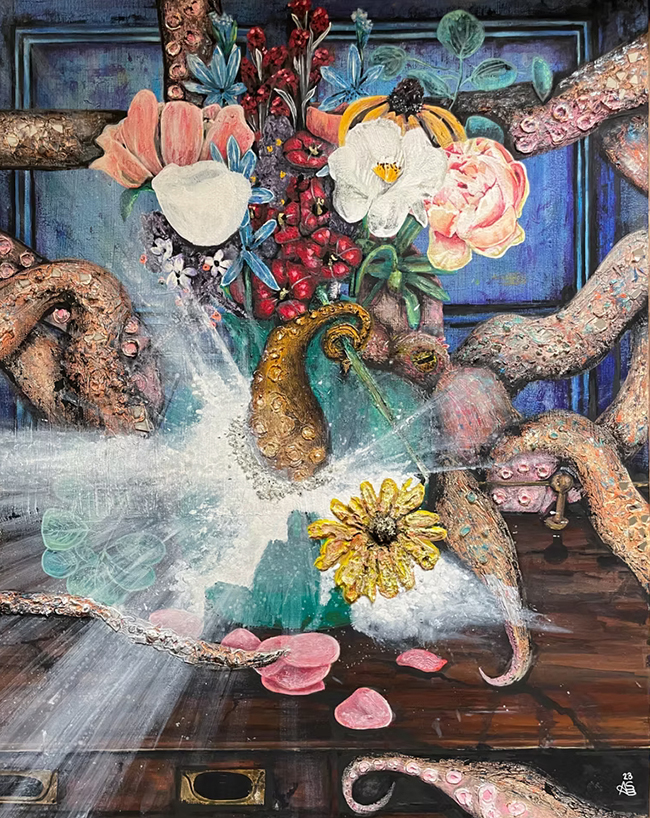Sally Barr didn’t set out to become a texture artist, but her work shows a deep understanding of how surface, depth, and raw material can carry emotion in a way that flat color alone can’t. Based in the UK, she draws from nature, her own life experience, and the complex terrain of human emotion—power, love, trauma, resilience. Her materials are layered and deliberate: acrylics, ink, charcoal, graphite. Her techniques—dry brushing, glazing over modelling paste or thick acrylic—create tension and contrast. For Sally, texture is more than a visual effect; it’s a language. It gives her work the honesty she needs to express what words can’t. When she brings in natural elements, it’s not just for aesthetics—it’s metaphor, memory, and message. Her paintings hold the viewer in that in-between space of vulnerability and understanding.

Let’s talk about her piece Amygdala Hijack. It’s 32 by 40 inches. Mixed media. It’s got weight—not just in physical texture but in concept too.
The title refers to a psychological term—when your brain’s emotional center overrides your logic in moments of stress or trauma. It’s that fight-or-flight shutdown where your body reacts before your mind can catch up. Sally’s painting is a portrait of that moment.
Front and center is an octopus arm crashing through glass. It’s not cartoonish or violent—it’s precise. You can almost hear the sharp snap of shattering glass. That sound, that moment of intrusion, is where the painting begins. It’s a visual metaphor for the way a trigger—especially one tied to trauma—can suddenly break through calm and pull the body into panic.
The arm is important. It doesn’t claw or grip; it extends a flower. There’s something hesitant, apologetic, almost tender in that gesture. Sally says this arm represents the moment of being “frozen in potential danger”—a physical response with no action taken. That’s why it holds the flower. The “sorry for the trouble” is not from the person who caused the trauma—it’s from the trauma itself. It’s your own brain trying to soothe after the shock.
The flower isn’t just a symbol of apology. Every flower in the painting has been chosen deliberately. Sally picks flowers based on type and color, each carrying its own emotional message. Maybe it’s a marigold for grief, or a bluebell for humility. You can’t always tell unless you ask her. But they’re there with purpose. And their softness contrasts the harshness of the cracked glass.
The background is layered with washes and heavy paint strokes, giving it the feeling of depth and turbulence beneath the surface. You can see where dry brushing adds that whisper of chaos, like wind moving across water, or static in the air. Sally’s use of texture here isn’t decorative—it makes the viewer feel unease, like something is shifting just beneath the calm.
But the piece isn’t hopeless. The message is, “This too shall pass.” That’s what Sally wants people to feel. That even in the middle of a hijack, in the noise and confusion, there is still softness somewhere. There is still room to breathe. The flower is the proof.
This painting isn’t trying to be clean or neat. It doesn’t wrap things up in a bow. It acknowledges the mess of trauma—how it crashes in, how it lingers, how it might even come with some strange kind of remorse. But it also says you’re not alone in it.
Sally doesn’t make art to impress. She makes it to connect. There’s a quiet defiance in her refusal to make things smooth or easy. Her work demands attention—not by shouting, but by saying something true. And Amygdala Hijack does just that. It’s a raw conversation between fear and compassion, brokenness and grace.
There are a lot of artists who work in mixed media, but Sally’s touch is different. She’s not just layering for the sake of technique. She’s layering experience. She’s turning sensation into surface. And for those who see themselves in her paintings, there’s comfort in knowing that someone else has been there too.
Her work doesn’t try to be definitive. It tries to be honest. And that’s what makes it stick.

